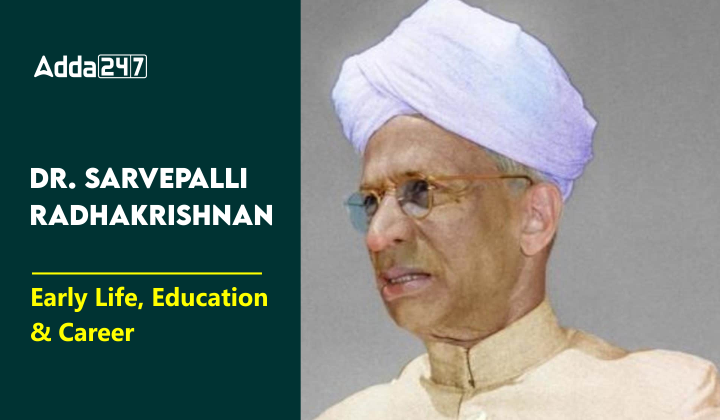Early Life, Education and Career [Current Affairs]
Dr. Sarvepalli Radhakrishnan was a remarkable figure in Indian history, known for his roles as a scholar, philosopher, and statesman. Although best remembered as India’s second President, his significant contributions to philosophy, education, and the promotion of Hinduism and Vedanta are equally noteworthy.
Early Life and Education of Dr. Sarvepalli Radhakrishnan
Sarvepalli Radhakrishnan was born on 5th September, 1888, in Tiruttani, Madras Presidency, British India. His parents, Sarvepalli Veeraswami and Sarvepalli Sita, were part of a Telugu-speaking Niyogi Brahmin family roots in the Andhra Pradesh’s Nellore district. Radhakrishnan’s early education took place in Thiruttani and Tirupati, but it was at Madras Christian College where he truly excelled, graduating in 1906 with a Master’s degree in Philosophy.
Academic Achievements of Dr. Sarvepalli Radhakrishnan
Sarvepalli Radhakrishnan embarked on a distinguished academic career, starting as a professor of philosophy at Madras Philosophy in 1909. He later became a Professor at the University of Mysore in 1918 and authored significant articles and books on philosophy, including “The Philosophy of Rabindranath Tagore” and “The Reign of Religion in Contemporary Philosphy.” In 1921, he assumed the prestigious King George V Chair of Mental and Moral Science at the University of Calcutta. His academic accomplishments led him to deliver notable lectures, receive a knighthood and serve as Vice-Chancellor of Andhra University and Spalding Professor at the University of Oxford.
International Recognition
Radhakrishnan’s global influence began with his attendance at international conferences and lectures. He participated in the International Congress at Philosphy at Harvard University and the British Empire Universities Congress, earning recognition as an expert in India thought. His Hibbert Lecture, “An Idealist View of Life,” delivered at Manchester College, Oxford, was another significant milestone in his intellectual journey.
Oxford Professorship and Nobel Nomination
In 1936, Radhakrishnan became a Fellow of All Souls College, Oxford and was appointed the Spalding Professor at Eastern Religions Ethics. He was even nominated for the Nobel Prize 27 times, 11 times for the Nobel Peace Prize and 16 times for Literature, highlighting the global acknowledgement of his contributions.
Political Career of Dr. Sarvepalli Radhakrishnan
Sarvepalli Radhakrishnan entered politics later after establishing himself as an international authority in philosophy. He actively participated in the Andhra Mahasabha in 1928 and supported the renaming of the Ceded Districts division as Rayalaseema. After India gained independence, he represented the nation at UNESCO and served as India’s Ambassador to the Soviet Union. Radhakrishnan was elected to the Constituent Assembly of India and subsequently became the first Vice-President of India in 1952. Later, he assumed the role of the second President of India from 1962 to 1967. His political motivations were rooted in defending Hindu culture and Indian intellectual traditions.
Why Dr. Sarvepalli Radhakrishnan’s Birthday celebrated as Teacher’s Day in India?
When Dr. Sarvepalli Radhakrishnan assumed the presidency of India, his students and friends approached him with a request to celebrate his birthday on September 5. In a humble response, he suggested that the day be dedicated to honoring teachers instead. Since then, 5th September has been celebrated as Teachers’ Day in India, a tribute to the profound impact of educators on society.
Philosophical Legacy
Radhakrishnan’s most enduring legacy lies in his philosophical contributions. He bridged the gap between Eastern and Western thought, defending Hinduism against Western misconceptions. He argued that Advaita Vedanta, with its emphasis on intuition and inner realization, represented the pinnacle of religious experience.
Dr. Sarvepalli Radhakrishnan – Awards & Honors
Dr. Savepalli Radharishnan received many award & honors, some of the important honors are as follows:
| Honor | Year | Country |
| Knight Bachelor | 1931 | British India |
| Bharat Ratna | 1954 | India |
| Order of the Aztec Eagle | 1954 | Mexico |
| Pour Le Merite | 1954 | Germany |
| Order of Merit | 1963 | United Kingdom |
Literacy Work By Dr. Sarvepalli Radhakrishnan
Here is the list of some important books written or authored by Dr. Sarvepalli Radhakrishnan:
| Books | Year |
| A Philosophy of Rabindranath Tagore | 1918 |
| Indian Philosophy | 1923 |
| The Hindu View of Life | 1926 |
| An Idealist View of Life | 1929 |
| Kalki or the Future of Civilization | 1929 |
| Eastern Religious and Western Thought | 1939 |
| Religion and Society | 1947 |
| The Bhagvatgita: with an introductory essay, Sanskrit Text, English Translation and Notes | 1948 |
| The Dhammapada | 1950 |
| The Principal Upanishads | 1953 |
| Recovery of Faith | 1956 |
| A Source Book in Indian Philosophy | 1957 |
| The Brahma Sutra: The Philosophy of Spiritual Life | 1959 |
| Religion, Science and Culture | 1968 |
Source: currentaffairs by adda247



![Union Agriculture Minister Shri Shivraj Singh Chouhan Launches AgriSURE Fund [Current Affairs]](https://officialsarkar.in/wp-content/uploads/2024/09/Union-Agriculture-Minister-Shivraj-Singh-Chouhan-today-launched-AgriSure-Fund-and-Agriculture-Invest-768x432.jpeg)
![Ulchi Freedom Shield Exercises [Current Affairs]](https://officialsarkar.in/wp-content/uploads/2024/08/Ulchi-Freedom-Shield-Exercises-768x432.png)
![First Recipient of Vir Chakra, Know His Name [Current Affairs]](https://officialsarkar.in/wp-content/uploads/2024/08/First-Recipient-of-Vir-Chakra-768x432.png)
![Indian women’s contributions across UAE honored at Indian Women Dubai Awards 2024 [Current Affairs]](https://officialsarkar.in/wp-content/uploads/2024/09/Indian-womens-contributions-across-UAE-honored-at-Indian-Women-Dubai-Awards-2024-768x432.jpg)
![First Indian Man to Receive Stalin Award, Know His Name [Current Affairs]](https://officialsarkar.in/wp-content/uploads/2024/08/First-Indian-Man-to-Receive-Stalin-Award-768x432.png)
![Yogesh Kathuniya Wins Silver In Men’s Discus Throw F56 [Current Affairs]](https://officialsarkar.in/wp-content/uploads/2024/09/Yogesh-Kathuniya-Wins-Silver-In-Mens-Discus-Throw-F56-768x432.png)